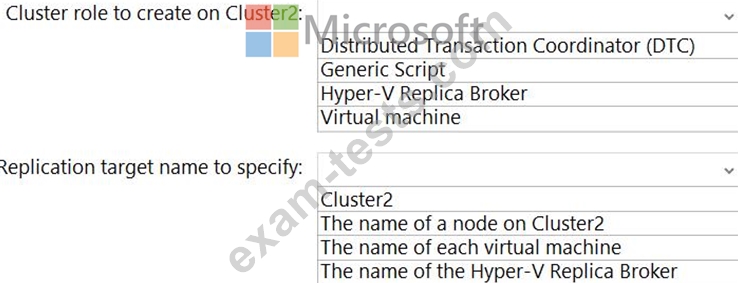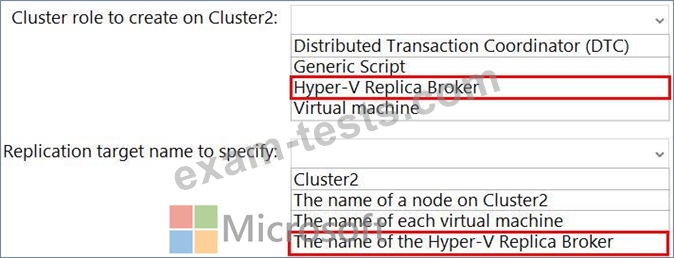Question 21
You have a Hyper-V failover cluster named Cluster1 at a main datacenter. Cluster1 contains two nodes that have the Hyper-V server role installed. Cluster1 hosts 10 highly available virtual machines.
You have a cluster named Cluster2 in a disaster recovery site. Cluster2 contains two nodes that have the Hyper-V server role installed.
You plan to use Hyper-V Replica to replicate the virtual machines from Cluster1 to Cluster2.
What should you do? To answer, select the appropriate options in the answer area.
NOTE: Each correct selection is worth one point.

You have a cluster named Cluster2 in a disaster recovery site. Cluster2 contains two nodes that have the Hyper-V server role installed.
You plan to use Hyper-V Replica to replicate the virtual machines from Cluster1 to Cluster2.
What should you do? To answer, select the appropriate options in the answer area.
NOTE: Each correct selection is worth one point.

Question 22
You plan to deploy the Azure Monitor agent to 100 on-premises servers that run Windows Server.
Which parameters should you provide when you install the agent?
Which parameters should you provide when you install the agent?
Question 23
Your network contains an on-premises Active Directory Domain Services (AD DS) domain named contos.com. The domain contains the accounts shown in the following table.

The domain is configured to store BitLocker recovery keys in Active Directory.
* Admin1 turns on BitLocker Drive Encryption (BitLocker) for volume C on Server1.
* Admin1 moves Server1 to OU1.
* Admin2 turns on BitLocker for removable volume E on Server2.
* Admin2 moves removable volume E from Server2 to Server1 and unlocks the volume.
On which Active Directory object can you each BitLocker recovery key? To answer, select the appropriate options in the answer area.
NOTE: Each correct selection is worth on point.


The domain is configured to store BitLocker recovery keys in Active Directory.
* Admin1 turns on BitLocker Drive Encryption (BitLocker) for volume C on Server1.
* Admin1 moves Server1 to OU1.
* Admin2 turns on BitLocker for removable volume E on Server2.
* Admin2 moves removable volume E from Server2 to Server1 and unlocks the volume.
On which Active Directory object can you each BitLocker recovery key? To answer, select the appropriate options in the answer area.
NOTE: Each correct selection is worth on point.

Question 24
You have an Azure virtual machine named VM1 that runs Windows Server. VM1 has boot diagnostics configured to use a managed storage account.
You are troubleshooting connectivity issue on VM1.
You need to run a PowerShell cmdlet on VM1 by using the Azure Serial Console.
Which four actions should you perform in sequence? To answer, move the appropriate actions from the list of actions to the answer area and arrange them in the correct order.

You are troubleshooting connectivity issue on VM1.
You need to run a PowerShell cmdlet on VM1 by using the Azure Serial Console.
Which four actions should you perform in sequence? To answer, move the appropriate actions from the list of actions to the answer area and arrange them in the correct order.

Question 25
You have three servers named Server1. Server1 and Server3 that run Windows Server and have the hyper V server rote installed. Server 1 hosts an Azure Migrate appliance named Migrate1.
You plan to migrate virtual machines to Azure.
You need to ensure that any new virtual machines created on Server 1. Server2 and Server3 are available in Azure Migrate
What should you do?
You plan to migrate virtual machines to Azure.
You need to ensure that any new virtual machines created on Server 1. Server2 and Server3 are available in Azure Migrate
What should you do?




